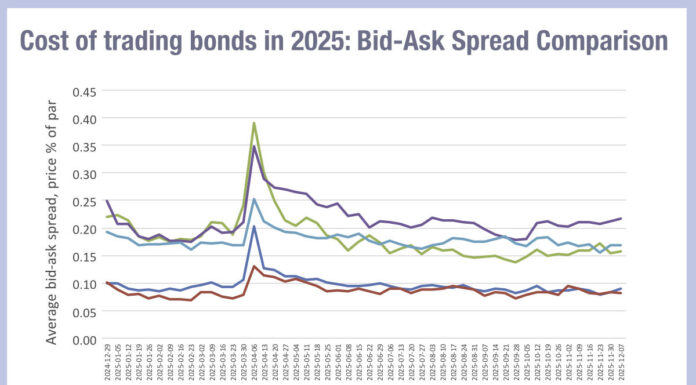Neptune’s COO, Byron Cooper-Fogarty, and head of data science, Ben Cohen, discuss the future of “axes” in the fixed income world.
Abraham Lincoln was a wise man. That headline quote can be applied to so many aspects of life, but essentially it is about preparation and accuracy. Given it mentions the word “axe”, it was too tempting not to apply it to fixed income markets and that mercurial piece of data known as an “axe”. What follows is the output of a conversation between the COO and Head of Data Science at Neptune regarding the future of this highly important but hard to pin down character in the bond market.
Ben: Byron, you’ve been around the bond markets for some time, how have axes been used historically?
 Byron: Thanks for the longevity praise, Ben…, in its simplest form, an axe is used by the sell side to advertise, quite specifically, what they’re most interested in selling or buying. On the buy side it was and still is used, almost exclusively, by the trading desks to find the best counterparty to approach on an order, where the size is above e-trading levels and where information leakage is a key consideration. Having said that, the use of axes, particularly by the buy side, has grown in my six plus years with Neptune.
Byron: Thanks for the longevity praise, Ben…, in its simplest form, an axe is used by the sell side to advertise, quite specifically, what they’re most interested in selling or buying. On the buy side it was and still is used, almost exclusively, by the trading desks to find the best counterparty to approach on an order, where the size is above e-trading levels and where information leakage is a key consideration. Having said that, the use of axes, particularly by the buy side, has grown in my six plus years with Neptune.
Ben: What does that evolution look like today?
Byron: Currently we see axes used on the buy side for many things. Naturally they remain key to blocks, but are also a component in dealer selection for small, auto-executed orders, which I wouldn’t have thought when Neptune started. More importantly, axes are being used upstream from the trading desks by their portfolio management colleagues. Having quality liquidity data alongside portfolios allows the PMs to be more opportunistic and to ensure their investment decisions can be represented in the form of an order that can realistically be traded.
Ben: Have you seen changes on the sell side as well?
Byron: Definitely. The buy-side mantra on axes is “real size in real time”, and dealers have responded, albeit there is further to go. We see larger axes being sent to trusted buy-side clients as dealers implement tiering. Sometimes change can throw in unintended consequences. I mentioned axes in auto-ex dealer selection. One issue we hear of from clients, particularly via the trading venues, is the proliferation of two-way axes to ensure selection in auto CRFQs. This is where Neptune is different, being independent of the eTrading process, we constantly monitor and ensure two-way axes are at a minimum.
Ben: There are clearly regional differences, in terms of how axes are formed, distributed and used. For instance, Europe seems to be ahead when it comes to using data in the trading process. Further, in Europe average axe size remains comfortably above those in the US, which is a little bit counterintuitive given average trade sizes across regions.
Byron: That has been our observation over the years. Likewise Asia, where we are doing more this year, has a very different approach to data given the liquidity and regulatory frameworks are highly fragmented. From a buy-side perspective, what we’ve also found is that AUM isn’t always a guide to sophistication in terms of technology and data use. In particular in the US there are some very large, very well known asset management firms that remain set in their ways regarding data and how it can augment human judgement. Having said that, there are several US based firms that are the most advanced in this area, having decided that data is key to evaluating opportunities and identifying patterns. The huge amount of data just can’t be processed by humans alone.
Ben, you’ve been working on historic axe data and portfolio trading analytics recently. What are you hearing from the marketplace?
 Ben: Most clients are comfortable seeing our axes at this point, either in our front end or via their OMS or EMS provider. However, because of the complexity of storing axe data and the limitations of the O/EMS, most still aren’t set up to perform simple queries, like seeing overnight position changes, or who was axed most recently on a bond where there are no current axes.
Ben: Most clients are comfortable seeing our axes at this point, either in our front end or via their OMS or EMS provider. However, because of the complexity of storing axe data and the limitations of the O/EMS, most still aren’t set up to perform simple queries, like seeing overnight position changes, or who was axed most recently on a bond where there are no current axes.
As a result, we’re being asked by clients for more ways to access the data, both real-time and historic. The buy-side trader’s toolkit has evolved to add coding skills, and distribution channels such as such REST API now allows trading and analysts direct connectivity.
Portfolio Trading is an increasingly important part of fixed income market structure. We’ve seen substantial growth in the number, and size of, algo/PT axes on Neptune. This has led buy-side clients to ask us to develop tools to make the process of dealer selection more data driven. This would be on the back of traditional axes, algo axes and streamed data, as well as historic data. Ultimately, the data will help point clients to which dealer or dealers to invite for specific portfolio trades, by allowing them to assess levels of axe coverage on the list of bonds.
Byron: Indeed, we’ve also had the sell side asking us about sending out portfolio axes, that is actual portfolios of bonds where clients can expect better execution levels, given the risk profiles the dealer has engineered on that group of bonds.
Ben: Clients are also after more detail on the source of the axes. For instance, we clearly mark axes that are algo or PT driven versus those coming from the traditional trading desks at the banks. Tagging axes with individual trader names is also becoming more common. Some clients would like it to go even further and have dealers identify axes as principle or agency. I’m not sure we are quite there yet, however as a data scientist, I’m certainly sympathetic to the desire for more granular data!
And before it seems like the buy side are the only beneficiaries of increased axe data, dealers are also paying closer attention to how their axes stand up to the rest of the market. As such, Neptune has placed a renewed emphasis on reporting to ensure dealers can see their ranks along with stats like average notional size by asset class, allowing them to compare themselves to peers on both quantity and quality. We’ve also launched an intraday axe service for dealers called “Neptune Echo”, which gives dealers a proprietary view of market opportunities and sector positioning that takes particular advantage of the datasets we have. This additional transparency should benefit both sides of the market.
Dealers are always looking for a better understanding of what happens after a client sees an axe – Byron, what’s the latest there?
Byron: Ah yes, the billion dollar question of axe attribution, AKA direct links to trading. Unfortunately, an unintended consequence of high regulatory barriers in Europe, and soon the US, means it is difficult to innovate in that area without substantial investment. But that is a topic for another discussion!
©Markets Media Europe 2023
©Markets Media Europe 2025













